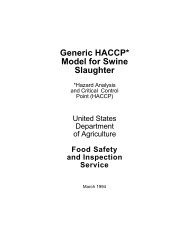Generic HACCP Model for Thermally Processed Commercial
Generic HACCP Model for Thermally Processed Commercial
Generic HACCP Model for Thermally Processed Commercial
You also want an ePaper? Increase the reach of your titles
YUMPU automatically turns print PDFs into web optimized ePapers that Google loves.
Appendix 4<br />
Hazard Analysis: <strong>Thermally</strong> <strong>Processed</strong>/<strong>Commercial</strong>ly Sterile<br />
The attached in<strong>for</strong>mation was prepared <strong>for</strong> products covered under the process: <strong>Thermally</strong><br />
<strong>Processed</strong>/<strong>Commercial</strong>ly Sterile. The literature search focused on foodborne illnesses and<br />
processing problems associated with thermally processed, commercially sterile canned products.<br />
The sources listed in this bibliography were gathered primarily on a search of databases (e.g.,<br />
Food Science and Technology Abstracts, Agricola, and Medline) on CD-ROM. Bound abstracts,<br />
such as the Food Safety and Technology Abstracts and the Bibliography of Agriculture, also<br />
could be used. References cited in scientific journal articles are another source of material.<br />
A 1971 finding of botulinum toxin in canned chicken vegetable soup and the death in 1974 of one<br />
person from botulism attributed to a product canned under USDA inspection prompted the<br />
revision of the canning regulations <strong>for</strong> meat and poultry. The new regulations were based on a<br />
<strong>HACCP</strong> concept - identifying critical control points setting critical limits, monitoring procedures,<br />
recordkeeping, and defining corrective actions <strong>for</strong> processing deviations or production errors,<br />
such as inadequate can seams. The scientific literature review emphasizes foodborne illnesses<br />
associated with thermally processed, commercially sterile product and the types of spoilage that<br />
result from processing or production problems.<br />
The attachment, "Incidents of Foodborne Illnesses from <strong>Thermally</strong> <strong>Processed</strong>, <strong>Commercial</strong>ly<br />
Sterile Canned Products," lists scientific journal articles on foodborne illnesses attributable to<br />
thermally processed, commercially sterile foods. The incidents of foodborne illness are not<br />
confined to commercially processed products but include illness resulting from improper home<br />
canning. The processing deviations (hazards), such as inadequate heating or control of acidity,<br />
which occur in home-canned product are similar to those which occur in a commercial<br />
environment. The extent sources, severity, and type of foodborne illness due to canned product<br />
is readily apparent from these references. These references also indicate the importance of<br />
controlling and monitoring canning procedures.<br />
The list of references under "Product Spoilage in <strong>Thermally</strong> <strong>Processed</strong>, <strong>Commercial</strong>ly Sterile<br />
Food Products" include spoilage of product resulting from underprocessing, post-process leakage<br />
contamination, or growth of thermophilic organisms, usually the result of storage at temperatures<br />
above 113þF. Underprocessing can be the result of inadequate time or temperature in retorting<br />
or poor control of a critical factor, such as pH. Post-process leakage contamination and<br />
thermophilic spoilage result from a break in the production process rather than failure in the<br />
process schedule. Can defects, such as dents, may affect the integrity of the can seams which may<br />
cause leaker spoilage. While thermophilic spoilage does not represent a potential health hazard,<br />
post-process leaker spoilage may result in the growth of gas-<strong>for</strong>ming anaerobes, such as C.<br />
botulinum.<br />
In addition to microbial spoilage, various physical and chemical contaminants may represent<br />
61



